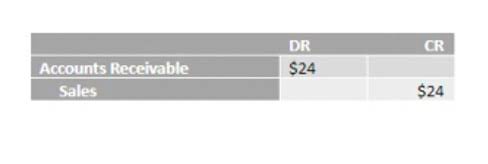Second, every time a sale occurs, we need to assign the cost of units sold in the middle column. In accounting, First In, First Out (FIFO) is the assumption that a business issues its inventory to its customers in the order in which it has been acquired. In this lesson, I explain the FIFO method, how you can use it to calculate the cost of ending inventory, and the difference between periodic and perpetual FIFO systems. Every time a sale or purchase occurs, they are recorded in their respective ledger accounts. However, as we shall see in following sections, inventory is accounted for separately from purchases and sales through a single adjustment at the year end.
Need Help With Order Fulfillment? ShipBob Can Help.
- One is the standard way in which purchases during the period are adjusted for movements in inventory.
- To find the cost valuation of ending inventory, we need to track the cost of inventory received and assign that cost to the correct issue of inventory according to the FIFO assumption.
- The IFRS provides a framework for globally accepted accounting standards, among them is the requirements that all companies calculate cost of goods sold using the FIFO method.
- In reality, sales patterns don’t usually follow this simple assumption.
- To see our product designed specifically for your country, please visit the United States site.
But it requires tracking every cost that goes into each individual piece of inventory. The opposite to FIFO, is LIFO which is when you assume you sell the most recent inventory first. This is favored by businesses with increasing inventory costs as a way of keeping their Cost of Goods Sold high and their taxable income low. But if your inventory costs are decreasing over time, using the FIFO method will increase your Cost of Goods Sold, reducing your net income. This can benefit businesses looking to decrease their taxable income at year end. For example, consider the same example above with two snowmobiles at a unit cost of $50,000 and a new purchase for a snowmobile for $75,000.
Get in touch with an expert. Talk with sales.
Since First-In First-Out expenses the oldest costs (from the beginning of inventory), there is poor matching on the income statement. The revenue from the sale of inventory is matched with an outdated cost. The remaining unsold 150 would remain on the balance sheet as inventory at the cost of $700. First, we add the number of inventory units purchased in the left column along with its unit cost.
Average Cost Method of Inventory Valuation
It’s recommended that you use one of these accounting software options to manage your inventory and make sure you’re correctly accounting for the cost of your inventory when it is sold. This will provide a more accurate analysis of how much money you’re really making with each product sold out of your inventory. While FIFO refers to first in, first out, LIFO stands for last in, first out. This method is FIFO flipped around, assuming that the last inventory purchased is the first to be sold.
Which method of inventory management should you use?
Under FIFO, your Cost of Goods Sold (COGS) will be calculated using the unit cost of the oldest inventory first. The value of your ending inventory will then be based on the most recent inventory you purchased. On the other hand, during a period of high inflation, using this method results in a higher value for the ending inventory and a higher gross profit (compared to other methods). Theoretically, in a first in, first out system, you’d sell the oldest items in your inventory first. Older products have a tendency to become obsolete over time due to product spoilage, wear and tear, and out-of-date design (if you update the design of the product at any point after your first order). With the FIFO method, you sell those older products first—ensuring that all items in your inventory are as recent as possible.
Should the company sell the most recent perishable good it receives, the oldest inventory items will likely go bad. The average cost method produces results that fall somewhere between FIFO and LIFO. For example, the seafood company, mentioned earlier, would use their oldest inventory first (or first in) in selling and shipping their products. is purchase return a debit or credit Since the seafood company would never leave older inventory in stock to spoil, FIFO accurately reflects the company’s process of using the oldest inventory first in selling their goods. For example, a company that sells seafood products would not realistically use their newly-acquired inventory first in selling and shipping their products.
With this method, companies add up the total cost of goods purchased or produced during a specified time. This amount is then divided by the number of items the company purchased or produced during that same period. To determine the cost of goods sold, the company then multiplies the number of items sold during the period by the average cost per item.
The company will report the oldest costs on its income statement, whereas its current inventory will reflect the most recent costs. FIFO is a good method for calculating COGS in a business with fluctuating inventory costs. They will handle all of the tedious calculations for you in the background automatically in real-time. This will ensure that your balance sheet will always be up to date with the current cost of your inventory, and your profit and loss (P&L) statement will reflect the most recent COGS and profit numbers.
The price on those shirts has increased to $6 per shirt, creating another $300 of inventory for the additional 50 shirts. This brings the total of shirts to 150 and total inventory cost to $800. Although the ABC Company example above is fairly straightforward, the subject of inventory and whether to use LIFO, FIFO, or average cost can be complex. Knowing how to manage inventory is a critical tool for companies, small or large; as well as a major success factor for any business that holds inventory. Managing inventory can help a company control and forecast its earnings. Conversely, not knowing how to use inventory to its advantage, can prevent a company from operating efficiently.
It takes less time and labor to implement an average cost method, thereby reducing company costs. The method works best for companies that sell large numbers of relatively similar products. Spreadsheets and accounting software are limited in functionality and result in wasted administrative time when tracking and managing your inventory costs. In the case of price fluctuations, you’ll need to calculate FIFO in batches. For example, let’s say you purchased 50 items at $100 per unit and then the price went up to $110 for the next 50 units.
However, these assumptions assist the companies to calculate the COGS- Cost of Goods Sold. In the earlier sections, we have seen that in FIFO, the oldest products are assumed to have been sold first and considers those production costs. It assumes the most recent products in the inventory are sold first and uses these costs.
As the size of your operations and inventory management increases, implementing FIFO gets harder. One disadvantage of using FIFO is the increased risk of inventory obsolescence, especially if you manage rapidly changing or seasonal products. This is because FIFO prioritizes the sale of older inventory items before newer ones, which could lead to potential losses if more in-demand products don’t sell.
The first in, first out (FIFO) method of inventory valuation is a cost flow assumption that the first goods purchased are also the first goods sold. In most companies, this assumption closely matches the actual flow of goods, and so is considered the most theoretically correct inventory valuation method. The FIFO flow concept is a logical one for a business to follow, since selling off the oldest goods first reduces the risk of inventory obsolescence. Under the FIFO method, the earliest goods purchased are the first ones removed from the inventory account. For example, in an inflationary environment, current-cost revenue dollars will be matched against older and lower-cost inventory items, which yields the highest possible gross margin. FIFO is also an important costing and inventory valuation method used by accountants to determine tax obligations and understand cost of goods sold.
When a business buys identical inventory units for varying costs over a period of time, it needs to have a consistent basis for valuing the ending inventory and the cost of goods sold. Determining which stock management method best suits your business depends on several factors. To determine if FIFO is the right choice for you, assess your inventory characteristics, understand customer demands and industry standards, and review your operational requirements and goals. Consider factors such as product shelf life, inventory turnover rates, and storage capacity.
In the following example, we will compare FIFO to LIFO (last in first out). Inventory is valued at cost unless it is likely to be sold for a lower amount. In the first example, we worked out the value of ending inventory using the FIFO perpetual system at $92. The wholesaler provides a same-day delivery service and charges a flat delivery fee of $10 irrespective of the order size. While the FIFO method has many benefits, it’s not without disadvantages. To see our product designed specifically for your country, please visit the United States site.
Fulfillment software with supplier management capabilities can help you and stakeholders track supplier performance, monitor delivery schedules, and communicate effectively. Additionally, demand forecasting and inventory planning tools can help you plan for future inventory needs and coordinate replenishment to maintain optimal inventory levels. Corporate taxes are cheaper for a company under the LIFO method because LIFO allows a business to use its most recent product costs first. Reduced profit may means tax breaks, however, it may also make a company less attractive to investors.
However, companies like car dealerships or gas/oil companies may try to sell items marked with the highest cost to reduce their taxable income. Assuming that prices are rising, this means that inventory levels are going to be highest as the most recent goods (often the most expensive) are being kept in inventory. This also means that the earliest goods (often the least expensive) are reported under the cost of goods sold.
What exactly is that accumulated depreciation account on your balance sheet? But when using the first in, first out method, Bertie’s ending inventory value is higher than her Cost of Goods Sold from the trade show. This is because her newest inventory cost more than her oldest inventory.
The company would report a cost of goods sold of $1,050 and inventory of $350. The first guitar was purchased in January for $40.The second guitar was bought in February for $50.The third guitar was acquired in March for $60. Under FIFO, the value of ending inventory is the same whether you calculate on the periodic basis or the perpetual basis. In the FIFO Method, the value of ending inventory is based on the cost of the most recent purchases.
With the LIFO method, every item entering the inventory would have a higher price, leading to a higher COGS, resulting in a lower gross profit in the income statement. From a tax perspective, lower gross profit means lower tax expenses (check the examples above). By reflecting lower inventory costs in COGS, FIFO can result in higher profits, improved financial statements, and potentially reduced tax liabilities. Leveraging demand forecasting capabilities, you can gain insight into your changing inventory needs while also minimizing excess stock issues and obsolescence problems. Adopting a proactive FIFO approach supported by technologies and automation tools can help you enhance overall supply chain efficiency, resulting in improved customer satisfaction and cost savings.
Ending inventory value impacts your balance sheets and inventory write-offs. FIFO is the best method to use for accounting for your inventory because it is easy to use and will help your profits look the best if you’re looking to impress investors or potential buyers. It’s also the most widely used method, making the calculations easy to perform with support from automated solutions such as accounting software. The FIFO method, or First In, First Out, is a standard accounting practice that assumes that assets are sold in the same order they are bought.
Inventory valuation can be defined as the amount correlating with the goods in the inventory at the end of the reporting or accounting period. This value is generated after considering the expenses incurred to acquire the stock and preparing it for sale. We want to make sure that we have assigned all the costs from beginning work in process and costs incurred or added this period to units completed and transferred and ending work in process inventory. For some companies, there are benefits to using the LIFO method for inventory costing. For example, those companies that sell goods that frequently increase in price might use LIFO to achieve a reduction in taxes owed.
The https://www.bookkeeping-reviews.com/ gives a very accurate picture of a company’s finances. It is also the most accurate method of aligning the expected cost flow with the actual flow of goods which offers businesses a truer picture of inventory costs. The simplicity of the average cost method is one of its main benefits.
That all means good things for your company’s bottom line—except when it comes to business taxes. Because of inflation, businesses using the FIFO method are often able to report higher profit margins than companies using the last in, first out (LIFO) method. That’s because the FIFO method matches older, lower-cost inventory items with higher current-cost revenue. Businesses on the LIFO system, on the other hand, see less of a margin between their current costs and their current revenue.
As a result, the company would record lower profits or net income for the period. However, the reduced profit or earnings means the company would benefit from a lower tax liability. The First-In, First-Out (FIFO) method assumes that the first unit making its way into inventory–or the oldest inventory–is the sold first. For example, let’s say that a bakery produces 200 loaves of bread on Monday at a cost of $1 each, and 200 more on Tuesday at $1.25 each. FIFO states that if the bakery sold 200 loaves on Wednesday, the COGS (on the income statement) is $1 per loaf because that was the cost of each of the first loaves in inventory.
The problem with this method is the need to measure value of sales every time a sale takes place (e.g. using FIFO, LIFO or AVCO methods). If accounting for sales and purchase is kept separate from accounting for inventory, the measurement of inventory need only be calculated once at the period end. This is a more practical and efficient approach to the accounting for inventory which is why it is the most common approach adopted. As you can see, the FIFO method of inventory valuation results in slightly lower COGS, higher ending inventory value, and higher profits. This makes the FIFO method ideal for brands looking to represent growth in their financials.
FIFO is also the option you want to choose if you wish to avoid having your books placed under scrutiny by the IRS (tax authorities), or if you are running a business outside of the US. With over a decade of editorial experience, Rob Watts breaks down complex topics for small businesses that want to grow and succeed. His work has been featured in outlets such as Keypoint Intelligence, FitSmallBusiness and PCMag. Jeff is a writer, founder, and small business expert that focuses on educating founders on the ins and outs of running their business.
Read More





